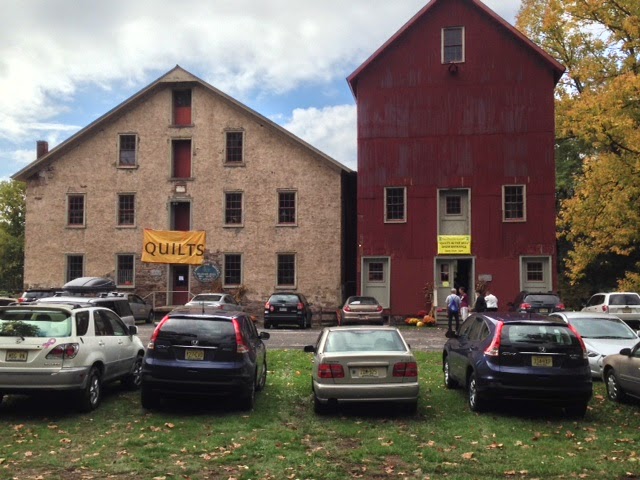There is a short list of places and activities I recommend to people visiting Cape May County, and this is on top of that list. It meets my basic history requirement (it's authentic, not made up for tourists), and it is just plane (make that
plain) interesting. It occurred to me recently while making such a recommendation that I hadn't been there for awhile. Yesterday I was happy to see that the museum takes up more of the space of its restored World War II hangar, and there are more planes and displays, including a tribute to the United States Coast Guard. By the way, I blogged about this museum back in 2011 for NJ.com and you can read that piece
here.
 |
| World War II-era Boeing-Stearman PT-17 Kaydet biplane |
The
National Air Station Wildwood (NASW) Aviation Museum is devoted to informing visitors about the WWII contributions of the Helldiver pilots. They trained at this airport during that war, and as you'll learn from the informative orientation video, 42 of them died during this intense training. Consider this: when things go right for these guys, they swoop down in their aircraft, drop the bomb, and then pull up immediately so that the exploding bomb doesn't catch their tail. That's dangerous enough, but what if something goes wrong while you're up there? What are you going to do?? So, that's the main thrust of this museum's message, but wait, there's more!
First let me explain that the NASW Aviation Museum is not in Wildwood as its name would have you suspect. It is closer to Rio Grande, NJ, but that name makes people think of Texas, and that would REALLY be confusing. The next closest municipality with a distinctive name was Wildwood. I guess "Cape May" was already taken by the then-Navy, now-USCG base. Wildwood was an entertainment hotspot even then, so the name probably had happy memories associated with it for the pilots who trained here.
The many military vehicles are set up so that visitors (YOU if you take my recommendation) can walk up to them, touch them, inspect some of their motors, and possibly even go inside them. You might recognize this big-bubbled Korean-War-era helicopter from the opening of M*A*S*H:
 |
| Bell 47 (H-13 Sioux in its military life) |
The NASW Aviation Museum considers the TBM-3E Avenger torpedo bomber the centerpiece of its collection. This plane was built at the General Motors Eastern Aircraft Division in Trenton, New Jersey, and was used for training and patrol along the coast. It is listed on the National Register of Historic Places, as is the Museum itself.
 |
| Fred poses in front of the gigantic TBM-3E Avenger propeller to show you how enormous it is. |
Not all of the aircraft here is WWII- or Korean War-era. Check out this helicopter, the AH-1 Cobra, which started production in 1967 and was used after the Vietnam war to the present day:
 |
| You get to check out the AH-1 Cobra's engine and look inside the cockpit. |
Not all of the vehicles here fly. This is a newer display (at least since I last visited): a Ford. This regular sedan was painted to represent NASW (the paint is original) and it was used to drive bigwigs around the base.
 |
| 1941 Ford Super Deluxe Fordor Sedan |
 |
| The Ford's blackout headlight |
 |
| Fred clowning around under the Ford's hood. |
So how did I get that cool shot of the Ford from above? No, I was not sitting on top of one of the planes or hanging from the hangar's rafters. The museum now has a replica of an Air Traffic Control Tower which is delicious for photographers because we can get shots like this one of multiple planes and stuff:
 |
| A bird's eye view of the front of the museum |
Be warned, photographers, that the light here is tricky, especially on a sunny day like yesterday, so have your photographic strategies ready!
Another nice touch yesterday was that the back door of the hangar was open. We weren't allowed to go out on the tarmac, but we could stand behind barricades and look out at more planes, and even watch a modern plane or two take off.
 |
| That's the Vultee BT-13 training plane poised by the back door, and the Russian Mikoyan-Gurevich MiG-15 with the red stars and '23' next to it. |
 |
| And here's a small modern plane taking off. |
Finally, there's the new US Coast Guard exhibit. The USCG Training Center where all recruits go for boot camp is nearby in Cape May, and that's the reason my parents settled in this region in the first place over sixty years ago. It was remote and wooded back then, and much of the human life had something to do with the Coast Guard. The helicopter below is original to the museum, but the Hummer, ship, and special exhibit are new.
 |
| HH-52A Seaguard, amphibious search-and-rescue helicopter |
 |
| The only time you'll see me behind the wheel of a Hummer, in this case a USCG Hummer |
 |
| "Always Ready" |
Impressive collection, don't you think? And consider this: I didn't even show you the Bird Dog, the Tomcat, the Tiger II, the Skyhawk, the Thunderbird, the gyrocopter, or Fred's favorite spot, the display of jet engines! Highly recommended. (Eat at the Flight Deck Diner or Erma Deli, both also highly recommended and nearby.)





















































